Soybean (Glycine max) is also known as the wonder bean, miracle bean, or “golden grain” due to its diversified applications. Soybean grain legume has around 40 percent good quality protein and 20 percent oil. Protein content in soybean is almost double in comparison with all other pulses. In addition to its high protein content, soybean has many other nutrients such as dietary fibre, vitamin A, C, E, and K, riboflavin, folate, and thiamine. It is also enriched with minerals such as iron, magnesium, zinc, selenium and calcium, and antioxidants. Besides nutritional benefits, soybeans provide several therapeutic benefits too. Soybean is one of the very few plants that provide a high-quality protein with minimum saturated fat. At present, 85% of the total soybean produced is used for soybean oil extraction. However, increased direct food use of soybean can benefit the utilization of its higher nutritional quality by converting it into different value-added products. Soy products find wide application as a versatile ingredient virtually in most of the food system, including bakery, breakfast cereals, beverages, infant formulas, dairy analogue, and meat analogue. Some of the important soybean-based products are discussed below.
1. Soymilk
Soymilk is a water extract of soybean and it is the base material for making soy paneer, soy-yogurt, and other dairy analogues. One kilogram of dry soybean yields 6 -8 liters of milk. Special features of soymilk are low cost, good nutrition, and suitability for lactose-intolerant people. Soymilk contains about 90% water, 2.5% fat and 3.5% protein, etc. Soy milk can be made at home with simple traditional tools or with a soy milk machine or juice maker. Large-scale commercial processing is also possible.

2. Soy Paneer (Tofu)
Soy paneer, popularly known as Tofu, is a coagulated and pressed soy protein. Tofu is a product somewhat similar to dairy paneer and is made by curdling the soymilk. One kilogram of dry soybean gives about 1.5-1.75 kg of tofu. Tofu is also called soybean curd, and it absorbs the flavour of the food with which it is cooked. Tofu can be eaten as it is, mixed with salads, fried, or prepared in a similar way as that of cottage cheese. Nutritionally, tofu is high in protein and vitamins, contains most of the nutrients. At 72% moisture, it contains about 14% protein and 9% fat. Soy paneer can be used in vegetable curry, paneer-pakoda paneer-paratha, cutlets, bread rolls, etc.
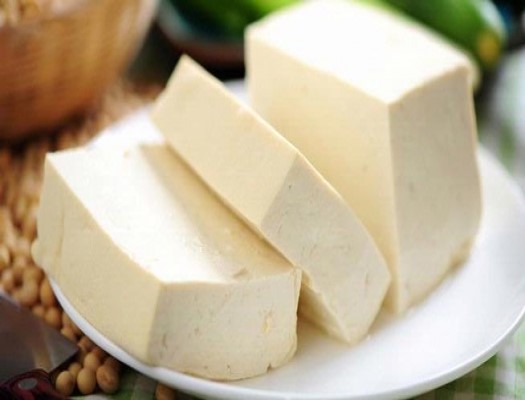
3. Soy Yogurt
Yogurt is a tasty and nutritional-rich product made by fermenting cow‘s milk to form an acidic gel. A yogurt analogue may be prepared from the soybean beverage base produced by the modified processes.
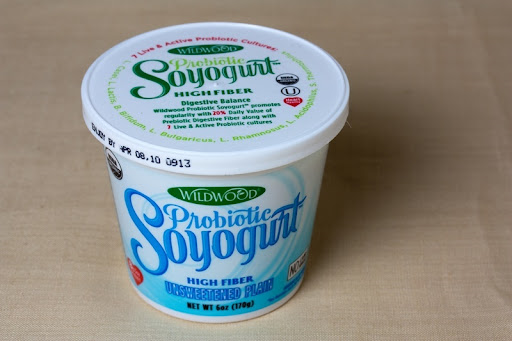
4. Soy Milk Powder
Soy milk powder is prepared by spray drying the soy milk. Soy milk powder enables the reconstitution of soy milk and solves the perishability problem.
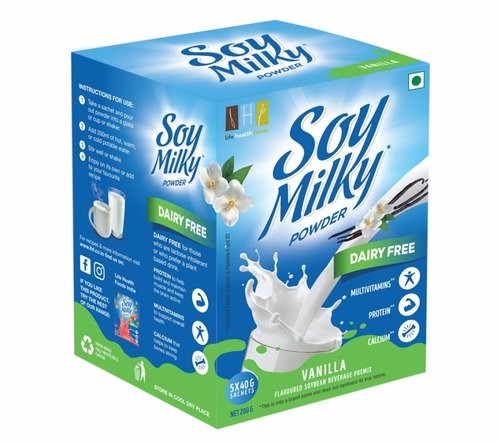
5. Soy Nuts
Soy nut is ready to eat the product. Soy nuts can be made by either deep fat frying or roasting. Chickpea flour can also be coated on these nuts for better taste. Most conventional nuts are incredibly high in fat but soy nuts have less fat and more protein compared to conventional nuts. Soy nuts are similar in texture and flavour to peanuts and less expensive than peanuts. Soy nuts have 50% more protein and 50% less fat than peanuts. These nuts contain about 45% good quality protein and 26% fat providing over 500 kcal energy per 100 g nuts.
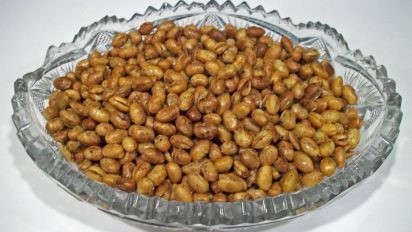
6. Full Fat Soy Flour (FFSF)
Soy flour is a good source of quality protein. FFSF is prepared by grinding the blanched soy dal after drying. One of the simplest ways of using soybean in the human diet is in the form of FFSF in combination with cereals and pulses. Ten percent addition of soy flour is recommended to start with and can be increased up to 20%. Preparation and use of recipes from soy-cereal/pulse blended flour do not demand any change in the traditional food habits of the people. Soy flour can be used for the preparation of chapati, poori, paratha, etc., and in bakery products.
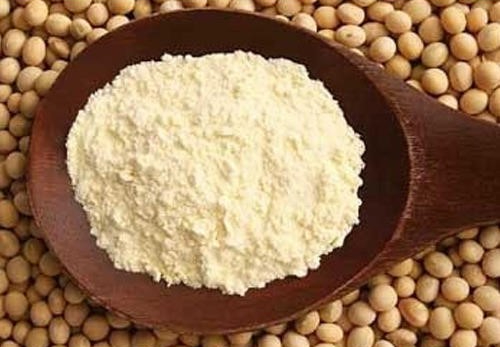
7. Soy Semolina (Soy Suji)
Soy suji can be used like wheat suji for the preparation of products like upma, halwa, laddu, etc., and is useful in the nutritional enhancement of conventional food products prepared using wheat suji. It contains about 40% protein and 20% oil and can be used up to 50% with wheat suji. It is prepared by the method of extrusion cooking of soy grits followed by milling to size. The protein content of soy suji is almost four times the wheat suji.
8. Textured Soy Protein
Textured soy protein (TSP) also known as soy chunks or soy nuggets is an extruded product prepared from the deoiled cake. These are available in textured form with fibrous and chewy properties like meat. TSP contains 7.5 to 8.5% moisture, 53 to 54% proteins, less than 10% fat, 2 to 3% fibre, and yellow to light brown colour.

9. Soy Fortified Biscuit
Protein content in bakery products ranges from 7-8%. It can be enhanced to 10-12% by incorporation of 10-14% soy flour in the recipe. Soy-based bakery products are good in taste and appearance. Bakery products are recognized as the most efficacious means of delivering supplementary nutrition to vulnerable segments of our society suffering from malnutrition.
10. Soy - Sattu
Sattu is ready to eat flour mixture of roasted cereal and pulse combination used as snack food in most parts of India, particularly in rural areas. Soy-maize sattu is fortified up to a level of 30% soybean. Protein and fat increase due to soy addition in ranges from 16 to 72% and 26 to 139%, respectively depending upon the level of soy fortification as compared to the conventional maize sattu.
(Content shared by Sh. Ajesh Kumar V and Sh. Chirag Maheshwari, Centre of Excellence for Soybean Processing and Utilization, ICAR‐Central Institute of Agricultural Engineering, Bhopal, Madhya Pradesh)